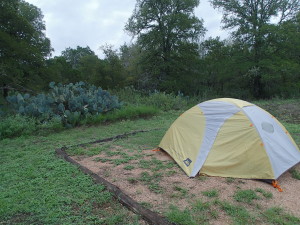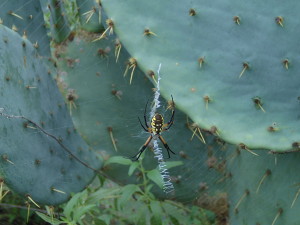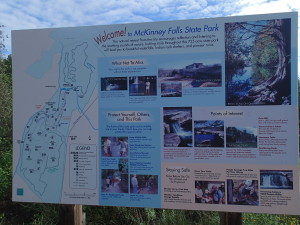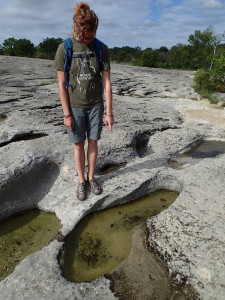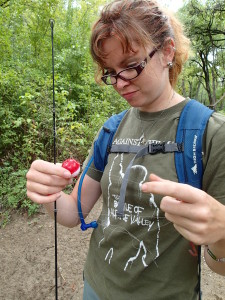When choosing a campground, you can usually go one of two ways: private or government. State and federal park campgrounds tend to be cheaper, but often at the expense of no privacy and no amenities (i.e. Internet). Private campgrounds come with a higher price tag, but often aren’t tucked away in the most beautiful places.
However, McKinney Falls State Park proved to be a little bit of the best of both worlds. Located in South Austin, this 726-acre park has been open to the city-dwelling public since 1976. It’s named after Thomas F. McKinney, who was one of Texas’s first colonists and made a fortune off of racehorse breeding, flour mill production, and slave labor.
Campsites range from $15 for walk-ins to $24 for spaces with water and 50-amp electric. The sites book up fast, even after Labor Day, so we secured the very last one for the weekend. All the sites are separated from each other pretty well, so you won’t feel cramped next to neighbors with monstrous RVs.
We were initially worried about camping the first night because it was raining, there were flood warnings, and the campground is near Onion Creek. However, each site has a “tent pit” that’s outlined with logs and we didn’t experience a single pool of water. Some sites shade trees and others have none, so choose wisely based on your tendency to sunburn.
The campsites have a wide open feel and there are plenty of cactus to make you feel like you’re camping in the desert. There are a couple visitor centers in the park and the staff will kindly talk your ear off if you let them. The grounds are incredibly well-maintained for a government facility and I had no complaints about the shops, bathrooms, or site grounds.
We went hiked a few of the McKinney trails, which are okay or biking but definitely better for hiking. Since “hill country” isn’t really all that hilly, the trails are pretty easy but still scenic. One pit stop along the way is “Old Baldy,” which is a 500 year old, 103-foot tall cypress tree along the trail.
There are two waterfalls, upper and lower falls, that are easy to get to and worth a stop. They aren’t very tall, but gazing into a waterfall is always relaxing, regardless of their magnitude. Due to recently heavy rains, we weren’t able cross over the falls and access the other side of the trails.
Texas state parks don’t require a fishing license to fish and much to my surprise, they loan out fishing poles for free. It’s a totally laid back transaction and some locations even have fake bait to give out too. We settled on an inopportune fishing spot under some shade trees and spent more time untangling the the line than actually casting out. It was a learning experience, that’s for sure.
One of the coolest things about McKinney Falls was its proximity to Austin. It was only about a twenty minute drive from downtown, which made it easy to sightsee during the day and camp at night. However, I never felt like I was right outside a large city while I was camping here: no traffic noise, no bright lights, and plenty of nature in all directions.
My final recommendation is to spring for a Texas State Park Pass if you’re going to camp for more than a couple days. It sucks parting with $70, but it starts saving you money on about day #3 of camping. The pass gets you out of paying the $6+ daily park fee, gives you 50% off your second night at any state campground, and gives you 10% off any supplies you buy at their stores.
Before this trip, beautiful parks were the last thing that came to mind when I thought of Texas. Believe it or not, there are 93 state parks here, and I look forward to visiting as many of them as possible during my trip.

